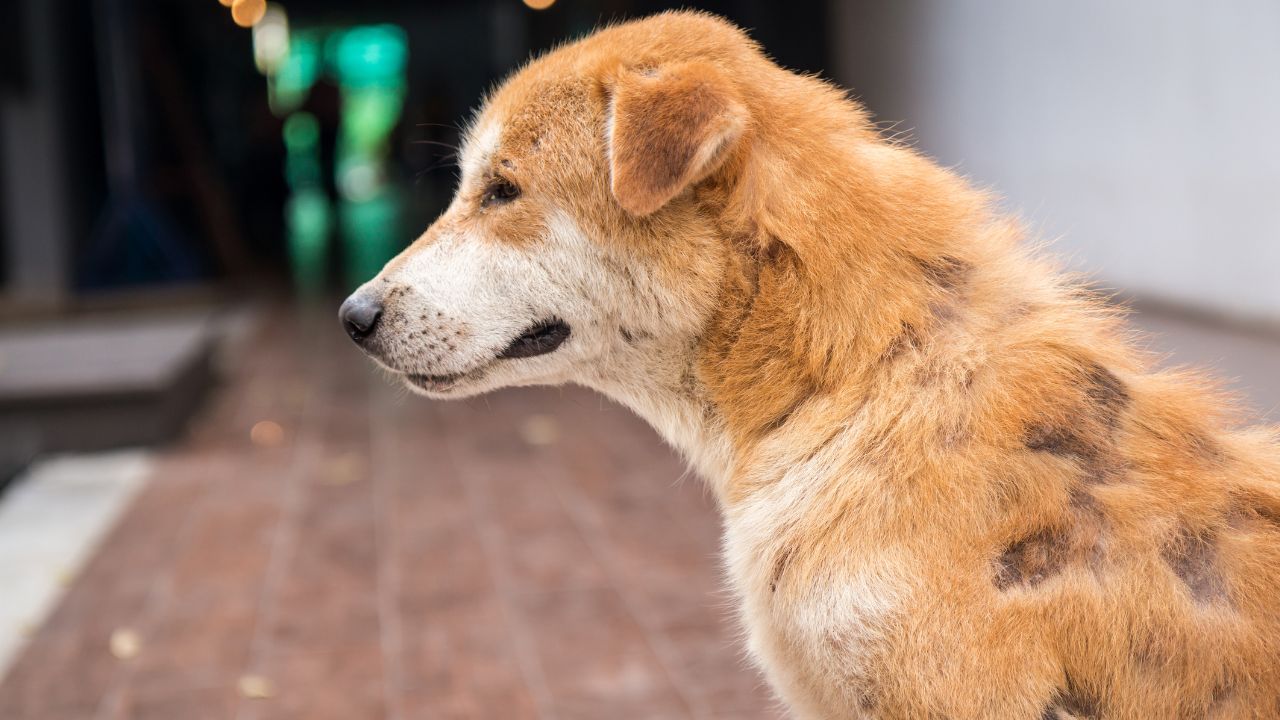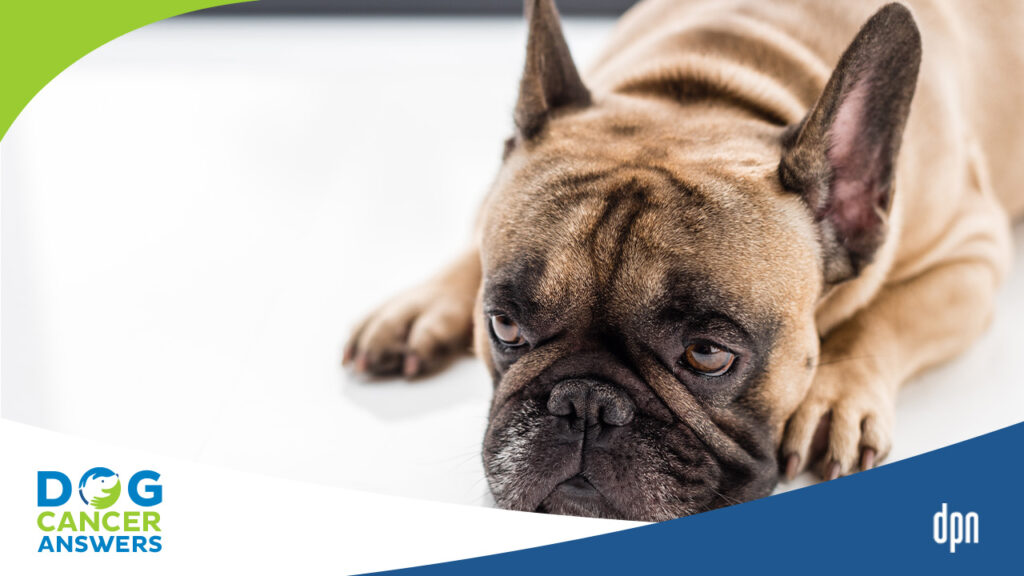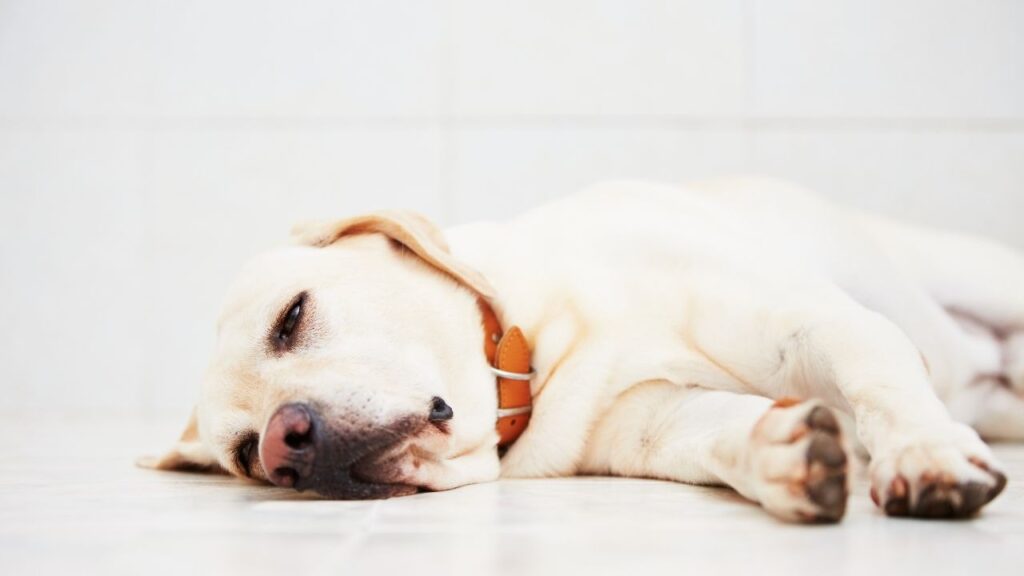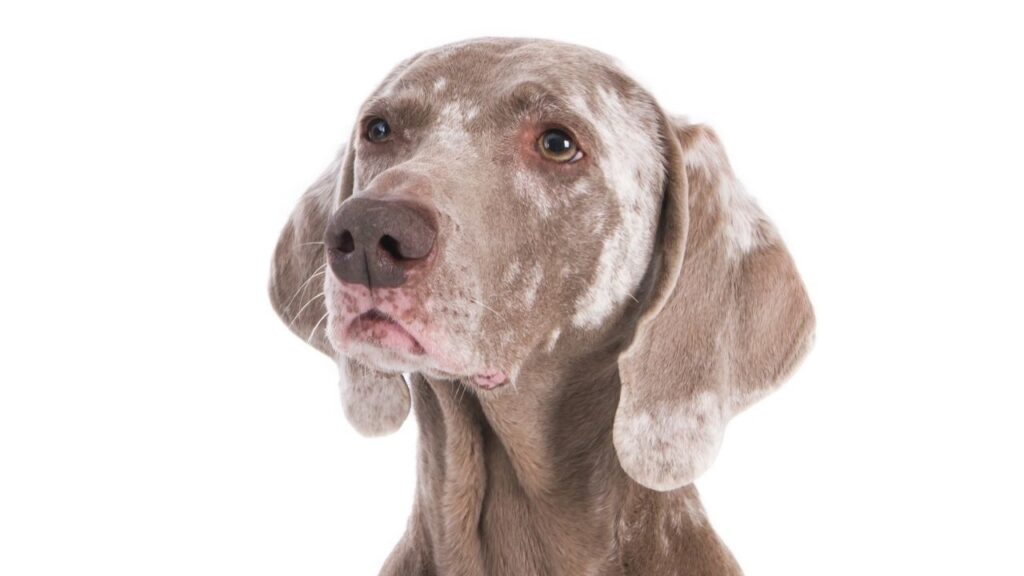Hair loss in dogs is uncommon in dogs with cancer, and even if your dog does experience this side effect, it won’t impact his quality of life.
Key Takeaways
- Dogs lose hair for many reasons, including stress, chemotherapy, radiation, steroids, topical medications, and cancers affecting hormones or the skin.
- To treat your dog’s hair loss, regular grooming is a must. A healthy diet is also important because healthy skin translates to a healthy coat.
- Chronic anemia, or lack of iron, could potentially cause hair loss, although this needs to be verified by your veterinarian.
- Symptoms of hair loss include increased shedding, patches of thin hair or bald skin, and skin irritation.
- Hair loss alone is not an emergency, but if a dog has bald patches or an abnormal shedding pattern, call your veterinarian or oncologist to make an appointment during regular hours to see what might be causing it.
It’s Not Just Shedding
Hair loss is the abnormal loss of hair or fur, either due to your dog’s health condition or as a side effect from treatments. The medical term for hair loss is alopecia.
Signs of hair loss include:
- Increased shedding
- Patches of thin hair coat or bald skin, with or without skin irritation
Hair loss is not the same as shedding, the process of releasing dead hairs from the follicles so that they fall out. Depending on your dog’s coat type, he may shed a bit constantly or may have big seasonal sheds. Normal shedding is nothing to worry about.
However, changes in your dog’s usual shedding cycle can lead to abnormal hair loss.

What Causes Hair Loss in Dogs
There are a variety of causes for hair loss that may affect your dog.
Stress
Stress – including visiting the vet’s office – can cause increased shedding. When your dog is anxious, his body releases epinephrine, which causes hair follicles to release hair. We don’t know exactly why this happens, but one theory is that having a loose coat could allow the dog to escape from a predator, leaving the predator with a mouthful of hair.1
Stress-shedding is transient and will stop once you and your dog return home.
Chemotherapy
Hair follicles are rapidly dividing2, just like fast-growing cancer cells. Chemotherapy often targets rapidly dividing cells, which means that hair follicles can be collateral damage.3
Dogs do not lose their hair while undergoing chemotherapy as often as humans do, however. Most dogs technically have fur with inactive follicles – once each individual hair has reached its target length, it stops growing. These inactive follicles are much less likely to be damaged by chemotherapy.4
Breeds such as Poodles and some terriers which have continuously growing hair are more likely to experience hair loss.3
Some chemo drugs that have been shown in studies to cause hair loss as a side effect include carboplatin5, cyclophosphamide5, and doxorubicin. The study that evaluated doxorubicin found that 28 out of 150 treated dogs (18.7%) experienced hair loss. The whiskers and eyebrows were the most likely areas to be affected, and dogs with curly or wire coats were more likely to have hair loss. The dose also made a difference, with dogs who received a higher cumulative dose over time having more extensive hair loss.6
Radiation
Like chemotherapy, radiation also targets rapidly dividing cells and can damage hair follicles. Hair loss due to radiation will only occur within the field that was treated – for example, if the dog receives radiation on a front leg, hair loss on his rump is not related to the radiation.
Hair loss generally occurs about three weeks into radiation treatment7, but this timeline can vary depending on the dose, frequency of treatments, and the individual dog. The hair may or may not grow back, and it may grow back in a different color or with a different texture.8,9 Texture changes sometimes resolve over multiple shedding cycles, but color changes are usually permanent.8
Steroids
High doses of steroids, such as prednisone, can cause hair loss. Long term use of steroids can also have this effect.10
Topical Medications
Any topical medication, from flea and tick preventives to an antibiotic cream, has the potential to cause hair loss. This hair loss will usually occur in the spot where the medication was applied and will resolve when treatment is finished or discontinued.
Cancers
Hair loss is not a common symptom of most cancer types. Cancers that may cause hair loss are those that affect hormone balances and metabolism, or the skin itself. Some examples are: 3,11,12
- Adrenal gland tumors
- Cutaneous lymphoma
- Pituitary gland tumors
- Thyroid cancer
Other Health Disorders
There are many other health conditions that can cause hair loss, ranging from mild to severe. Here are some examples: 10
- Fleas and other external parasites
- Kidney dysfunction or failure
- Liver dysfunction or failure
- Malnutrition
- Chronic anemia
- Low blood pressure
- Hormonal imbalances
What to Do
Groom your dog regularly at home to remove dead hair and prevent mats from forming. This will help to keep his skin healthy, and you will also become familiar with his normal coat cycle.
If you notice bald patches or abnormal shedding, schedule an appointment with your veterinarian to identify the cause and determine the proper treatment, if needed.
If your dog has already been diagnosed with cancer and is undergoing treatment, notify the vet or oncologist who is following his case. They can let you know if the hair loss is likely to be a side effect from treatment or not.
When to Call Your Vet
Hair loss by itself is not an emergency. If your dog is developing bald patches or has an abnormal shedding pattern, you can schedule an appointment during regular business hours.
Depending on the type of cancer that your dog has or the treatment(s) that he is receiving, your veterinarian may simply advise you to keep brushing your dog regularly and ride it out.
If your dog is presumed healthy or if his skin shows other abnormalities in addition to the hair loss, your veterinarian will want to find the cause. They will start by doing a physical exam and may recommend skin scrapes and/or bloodwork to diagnose the underlying cause.
Things that Help
The two best things to keep your dog’s coat and skin healthy are to brush him regularly and feed him a complete and balanced diet. If your dog is already eating a balanced diet, ask your veterinarian about adding an omega 3 fatty acid supplement for extra skin support.
Medicated baths may be helpful in some cases. Do not use a medicated shampoo unless instructed by a veterinarian.
Is This a Sign of the End?
Nope! Hair loss by itself does not mean that your dog is dying.
- OVRS Staff. Is Your Dog’s Shedding Related to Stress? Oakland Veterinary Referral Services. https://www.ovrs.com/blog/dogs-shedding/. Published May 5, 2021. Accessed December 9, 2022.
- Fullerton E. Chemotherapy-Induced Side Effects in Pets: Prevention and Treatment. Today’s Veterinary Nurse. https://todaysveterinarynurse.com/oncology/chemotherapy-induced-side-effects-prevention-and-treatment/. Published August 30, 2018. Accessed December 9, 2022.
- What You Need To Know About Canine Cancer Treatments And Hair or Fur Care. ImpriMed. https://www.imprimedicine.com/blog/fur-loss-and-care. Published November 29, 2021. Accessed December 9, 2022.
- Anivive Team. Will My Dog with Cancer Lose Their Hair? Will They Sleep More? Anivive. https://anivive.com/learn/article/will-my-dog-with-cancer-lose-their-hair-will-they-sleep-more. Published March 27, 2021. Accessed December 9, 2022.
- Jae-June R, Ill-Hwa K, Dae-Youn H, Hyun-Gu K. Combination Chemotherapy of Carboplatin and Cyclophosphamide in a Dog with Mammary Tumors Metastasized to the Lungs. Korea Science, Journal of Veterinary Clinics. https://koreascience.kr/article/JAKO201610235349870.page. Published December 30, 2016. Accessed December 9, 2022.
- Rajewski G. Chemo and Furry Coats. Tufts Now. https://now.tufts.edu/2017/05/09/chemo-and-furry-coats. Published May 9, 2017. Accessed December 9, 2022.
- Radiation Therapy – Side Effects. Veterinary Specialty Center. https://www.vetspecialty.com/specialties/medical-and-radiation-oncology/radiation-therapy-side-effects/. Published November 3, 2022. Accessed December 9, 2022.
- Mayer MN, MacDonald VS. External beam radiation therapy for thyroid cancer in the dog. Can Vet J. 2007;48(7):761-763.
- Mayer MN, Grier CK. Palliative radiation therapy for canine osteosarcoma. Can Vet J. 2006;47(7):707-709.
- What Causes Hair Loss in Cats and Dogs? Columbia Veterinary Emergency Trauma and Specialty. https://cvets.net/hair-loss-cats-dogs/. Published March 7, 2019. Accessed December 9, 2022.
- Wooten S. 7 Subtle Signs of Cancer in Pets That Most Pet Parents Overlook. PetMD. https://www.petmd.com/7-subtle-signs-cancer-pets-most-pet-parents-overlook. Published May 1, 2019. Accessed December 10, 2022.
- Stoewen D, Pinard C. Lymphoma of the Skin. VCA Animal Hospitals. https://vcahospitals.com/know-your-pet/lymphoma-of-the-skin. Accessed December 10, 2022.
Topics
Did You Find This Helpful? Share It with Your Pack!
Use the buttons to share what you learned on social media, download a PDF, print this out, or email it to your veterinarian.






